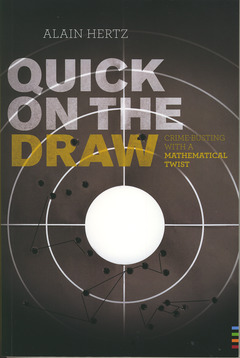Notice
Quick on the draw
Crime-busting with a mathematical twist
Auteur : HERTZ Alain
Langue : Anglais
Thème de Quick on the draw :
Ouvrage 198 p. · 15x23 cm · Broché
ISBN : 9782553016264
Presses internationales Polytechnique
Prologue
CHAPTER I Respecting the rules In which Manori introduces his friend and colleague Courtel to the basics of graph theory, and uses it to show how the COPS conference organizers won’t be able to create the work groups they have in mind for their “unsolved cases” sessions.
CHAPTER II The villas of the Bellevue In which Manori catches Courtel in a Marseillais-style exaggeration, and also solves a problem with the hotel villas’ water, gas and electricity lines.
CHAPTER III The case of the missing files In which Manori attends an “unsolved cases” session with his police colleagues, and helps finger the culprit in a complicated case that starts with a murder and ends with the mysterious theft of a stack of files from a high-security police archives.
CHAPTER IV The case of the hidden inheritance In which Manori helps a colleague by using graph theory to tackle a case of inheritance fraud, proving that an anonymous caller can’t possibly have put his hands on a paranoid millionnaire’s fortune... and showing the real inheritors how they can.
CHAPTER V The unhappy employee In which the ever-friendly Manori uses a magic card trick to help an unhappy hotel maid find her smile again by getting a fairer set of job responsibilities.
CHAPTER VI The case of the runaway mouse In which Manori helps find a very expensive mouse that escaped from Courtel’s lab back home... and makes Courtel look like a genius in the process.
CHAPTER VII The case of the hooded man In which Manori identifies a hooded man who committed a robbery while on break from his prison sentence, impressing his colleagues in another “unsolved cases” session.
CHAPTER VIII The getaway car In which Manori helps Courtel solve a puzzle and avoid looking stupid in front of his daughter, and then finds a way to give the entire Courtel family an extra couple hours of sleep.
CHAPTER IX The Sudoku apprentice In which Manori helps a young Sudoku player solve a couple of challenging puzzles on the flight home from the COPS conference. Author’s notes Bibliographic references Acknowledgements Book’s website (may be accessed through Presses internationales Polytechnique’s website)
Ces ouvrages sont susceptibles de vous intéresser

Applied Reactor Physics 80,72 €





